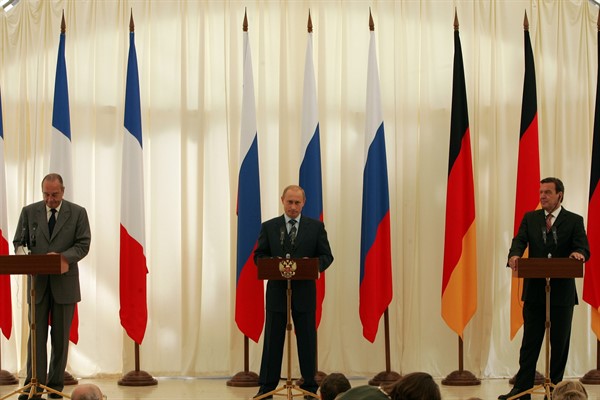On a warm summer evening in July 2005, Russian President Vladimir Putin, together with the German chancellor and French president at the time, Gerhard Schroder and Jacques Chirac, looked on as a lavish fireworks display entertained a vast crowd in the Baltic city of Kaliningrad. In commemoration of the 750-year anniversary of the founding of what had once been the Prussian city of Konigsberg, the Russian government that had inherited Kaliningrad after its conquest by the Soviet Union during World War II had put on elaborate festivities to celebrate its complex history.
For Putin, Kaliningrad was of both personal and strategic importance as the region in which his then-wife had grown up and as a symbol of Russia’s return to great power status through naval expansion close to the heart of NATO. As an exclave that had been handed to the Russian Soviet Republic under the USSR, Kaliningrad remained under Moscow’s control even after its borders were cut off from the rest of Russia when Lithuania declared independence upon the Soviet Union’s collapse. While the participation of Schroder and Chirac at the 2005 festivities was intended to signal Russia’s partnership with Europe’s most powerful states, the lack of invitations to Polish, Swedish or Lithuanian leaders sent a more ominous signal about who Putin believed should call the shots around the Baltic Sea.
In the decade that followed, the European Union’s hopes that Kaliningrad’s development could anchor cooperation with Russia were displaced by fears over how Putin might use it as a springboard for imperial ambitions. Russian military exercises practicing amphibious landings stoked fear in Sweden that its neutral status might tempt Moscow to seize the island of Gotland in the assumption that an attack on Swedish territory would not elicit a swift NATO response. Concern that Russian armored divisions could seize the Suwalki gap—the sliver of Polish territory separating Kaliningrad from Belarus—to cut the Baltic states off from the rest of NATO led the Polish and Lithuanian governments to beef up their defenses around the exclave in the years running up to the current Russo-Ukrainian War. Recent exercises simulating nuclear strikes in Europe by Iskander ballistic missiles stationed in Kaliningrad represented a further escalation in Putin’s use of the region as a means through which to pressure the EU.

